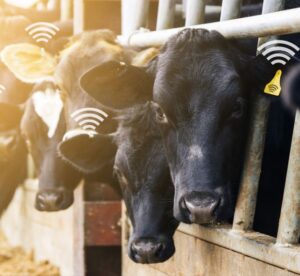The world is rapidly changing. As new global challenges such as a growing population and climate change are combined with new green and digital innovations, we can but hazard a guess what the world will look like in 50 years’ time. But who better to ask than our TopDutch experts for a vision of the future? We’re starting off this series with EV Biotech CEO Linda Dijkshoorn, who predicts that by 2070, the entire biological infrastructure will be digitized.

If it were up to Linda Dijkshoorn, our increasing knowledge of biological systems and DNA – ‘the biological software’ – would be the big disruptor of food production. Linda Dijkshoorn is currently CEO of EV Biotech, an innovative company that produces raw materials such as vanilla using vegetable waste streams and micro-organisms. The company makes use of biotechnological knowledge, digital technology and chemical expertise.
‘In fifty years’ time, the world will be a natural ecosystem with a strong technological infrastructure. The technology will be seamlessly able to simulate and predict the complex natural processes. We now understand only very little about everything that nature takes care of. By 2070, computers will be so powerful that we’ll be able not only to understand nature, but also to correct the processes that we can’t yet control.’
Ingredient #1 Digital ingenuity
‘Consider what microbiological processes, or the development of fungi and some creepy-crawlies – insects, worms, single-celled creatures – bring about in the soil. Ingenious technology will make it possible to predict all the processes at once. This isn’t yet possible. We’re able to correct one problem at most – such as the formation of fungus on crops – by means of crude measures. But everything we do has side effects, which often have a negative impact on the environment. Chemical pesticides cause the soil to deteriorate, for example.’
‘The models and scenarios that were made up until recently to predict the future are still very rough. Models for super-complex systems have not been possible. With the steady increase in computing power, it is becoming possible to build digital models that can predict and imitate complex biological and chemical processes, as well as calculate the side-effects and the mutual impact of processes.

This is happening now at academic level, but one day it will be common practice. That will radically change agri- and food production. ‘Biologists still often say that biology is so complex that it cannot be modelled. That’s true right now, but it will no longer be so in the future. We’re getting to understand biological systems better and better.’
‘In the coming decades, we’ll learn how to use biological processes. Now we have to make an educated guess about the development of an entire organism, such as a head of lettuce in the ground. Each season you can try to improve the soil quality, conditions and variety of the crop and after years you might make some progress. This process of trial and error will no longer be needed in the future – complex digital models will replace this process and make it possible to carry out 1,000 tests in one day using digital tests to optimize the plant’s environment immediately based on the results. By 2070, we’ll be able to bend biology to our will.’
Ingredient #2 Micro-organisms
‘A large part of our food will no longer come from plants, but from micro-organisms. A lot of protein-based medication is already cultured with micro-organisms. Cultured meat will one day be commonplace. Not everything we eat will need arable farming in the future. Vitamins, flavorings, aromas and chemical compounds that are now extracted from plants will be produced by micro-organisms.’
‘The chemical industry will be totally clean by 2070. The TopDutch region, which is already at the forefront in this area, will have its entire production climate-neutral and circular by 2050. High-quality chemical products, such as extracts and raw materials for the beauty industry, will be produced entirely organically, through the fermentation of agricultural waste streams by micro-organisms, for example. Micro-organisms are carbon-neutral, but they do need sugars as food – and for that they need crops.’

Ingredient #3 Genetically Modified Organisms
‘In fifty years’ time, the world’s population will have grown so much that there won’t be enough suitable arable land to grow all the food we need. Fortunately, mankind will be saved by genetically modified organisms (GMOs). This technology facilitates the production of climate-friendly biological pesticides. By using geno-mining from public datasets, we’ll discover interesting molecules that act as de facto pesticides. That will produce stronger, more resistant crops that we will use to feed the world.’
“By using geno-mining from public datasets, we’ll discover interesting molecules that act as de facto pesticides.”
Linda Dijkshoorn, CEO EV Biotech
‘Genetic modification has a bad name. But the method of crossing and selection has been used in agriculture for millennia. Cattle, fruit, vegetables, cereals – everything we consume now has been crossed so many times that it has become better flavored, richer in nutrients and more resistant to disease and drought. Genetic modification is in fact a means, just like a pencil. With a pencil you can write a hateful letter, but you can also use it to create a work of art. It all depends on what the user wants to do with it. The restriction in the European Union on the genetic modification of food and crops is now being circumvented, for example, by bombarding plants with UV radiation in the hope that it will produce useful mutations – a shotgun method, if not worse than genetic modification.’
‘This controversy can also be seen as an opportunity: it is precisely by combining the pioneering approach to GMOs with an ethical discussion that we can achieve controlled innovation in the TopDutch region. For example, you have to extensively test GMOs for harmful side-effects. We can outline a picture of the future, but if politicians fail to inform themselves about the prospects offered by this technology, we can seize this opportunity.’
Linda’s vision for the future of TopDutch
‘Milk is still a unique product, for which we need cows. Vegetable milk substitutes lack the essential properties that cow’s milk possesses. You can’t make cheese out of oat milk, for example. In the TopDutch region I see opportunities in the development and application of tech dairy, such as sustainable synthetic milk, with a lower carbon footprint than cow’s milk. In the production of cow’s milk, I see an agricultural sector in the TopDutch region that produces even higher quality delicatessen products. Specialized farmers produce the best premium milk and milk products in a balanced way in their own ecosystem.’
‘In the foreseeable future, arable farming will use all its residual flows for high-grade production purposes. Pure residual streams are becoming the hallmark of the agri sector in the TopDutch region. The chemical industry will be characterized by total transparency about the production processes. This will establish close cooperation between the agricultural sector and the chemical industry. If they buy products from the TopDutch region, global consumers will know how they are produced and what impact this has had on the environment.’

Linda Dijkshoorn is CEO and founder of the biotech company EV Biotech. She’s an entrepreneur and PhD candidate at the department of Pharmaceutical Biology at the University of Groningen in the group of Professor Wim Quax. EV Biotech uses innovative technology to create micro-organisms that can produce high-quality molecules.
Source: TopDutch
